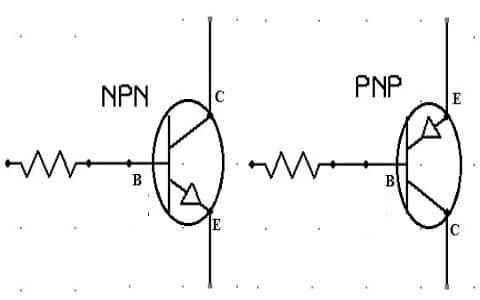Transistors are the workhorses of electronic circuits, performing tasks ranging from signal amplification to digital switching. The proper functioning of a transistor is contingent upon precise design considerations, and one critical aspect is the choice of base resistance. The base resistor plays a pivotal role in controlling the input current to the transistor, thereby influencing its amplification or switching capabilities. In this article, we delve into the intricate process of choosing base resistance for transistors, exploring the underlying principles, calculations, and practical considerations that engineers and hobbyists should take into account.
Choosing Base Resistance for Transistors
For choosing base resistance for transistors, there are several factors that need to be considered which are discussed below.

Choosing Base Resistance for Transistors
Understanding Transistor Operation:
Before looking into the intricacies of choosing the base resistance, it’s essential to have a fundamental understanding of how transistors operate. There are two primary types of transistors: Bipolar Junction Transistors (BJTs) and Field-Effect Transistors (FETs). For the purpose of this discussion, we’ll focus on BJTs.
To understand the operation of the BJT’s and FET’s click on the link below:
Field Effect Transistor or FET.
Bipolar Junction Transistor or BJT.
Importance of Base Resistance:
The base resistance (RB) in a BJT circuit is crucial because it limits the current flowing into the base. Controlling this current is essential for ensuring the transistor operates within its specified parameters and avoids potential damage due to excessive currents.
The relationship between the base current (IB), base voltage (VB), and base resistance (RB) is governed by Ohm’s Law (IB = VB/RB). Properly choosing the base resistance helps achieve the desired biasing conditions for the transistor, influencing its gain, switching speed, and overall performance.
Factors Influencing Base Resistance:
Several factors come into play when determining the appropriate base resistance for a transistor in a given circuit. Let’s explore these factors in detail:
Transistor Specifications:
The datasheet of the transistor is a crucial resource. It provides information on the maximum base current (IB max) and the current gain (hFE or β) of the transistor. These values guide the selection of the base resistor.
Biasing Point:
The biasing point of the transistor, which determines the operating point on its characteristic curves, influences the choice of base resistance. The desired biasing conditions ensure that the transistor operates in its active region, providing the required amplification or switching characteristics.
Collector Current (IC):
The collector current is the current flowing from the collector to the emitter. It is a key parameter in determining the base current and, consequently, the base resistance. The collector current requirements of the circuit impact the choice of RB.
Voltage Supply:
The voltage supply to the circuit influences the choice of base resistance. It is essential to ensure that the base-emitter junction is properly biased and that the base-emitter voltage (VBE) is within the recommended range.
Calculating Base Resistance:
The calculation of base resistance involves a series of steps to achieve the desired transistor biasing conditions. Here’s a simplified approach to calculating base resistance:
Determine Collector Current (IC):
The collector current (IC) is a critical parameter that needs to be determined based on the requirements of the circuit. This value is often provided in the circuit specifications.
Determine Base Current (IB):
Using the current gain (hFE or β) from the transistor datasheet, calculate the base current (IB) required to achieve the desired collector current: IB = IC / hFE.
Choose a Desired Base-Emitter Voltage (VBE):
Typically, a silicon transistor has a base-emitter voltage (VBE) of around 0.6 to 0.7 volts. Choose a value within this range based on the specific characteristics of the transistor.
Apply Ohm’s Law:
Use Ohm’s Law (IB = VB / RB) to calculate the base resistance. Rearrange the formula to find RB: RB = VB / IB.
Practical Considerations:
While calculations provide a theoretical foundation for choosing base resistance, practical considerations also play a crucial role:
Standard Resistor Values:
Choose base resistor values from standard resistor series to simplify the implementation and ensure the availability of components.
Temperature Considerations:
The characteristics of transistors can vary with temperature. Consider the temperature range in which the circuit will operate and account for potential variations in transistor parameters.
Safety Margin:
Incorporate a safety margin in the base resistance calculation to ensure that the transistor operates reliably under different conditions, including variations in transistor characteristics and temperature.
Experimentation:
Practical experimentation is valuable. Build the circuit, measure actual values of base current and voltage, and fine-tune the base resistance for optimal performance.
Examples of Base Resistance Calculation:
Let’s consider a simple example to illustrate the base resistance calculation:
Suppose we have an NPN transistor with the following specifications:
- IC (Collector Current) = 5 mA
- hFE (Current Gain) = 100
- VBE (Base-Emitter Voltage) = 0.7 V
Determine Base Current (IB):
- IB = IC / hFE
- IB = 5 mA / 100 = 0.05 mA (or 50 µA)
Choose Desired Base-Emitter Voltage (VBE):
- VBE = 0.7 V
Calculate Base Resistance (RB):
- RB = VBE / IB
- RB = 0.7 V / 50 µA = 14 kΩ
In this example, the calculated base resistance (RB) is 14 kΩ.
Please refer to this for How to Select a Transistor.
Conclusion:
Choosing the appropriate base resistance for a transistor involves careful consideration of various factors, including transistor specifications, biasing conditions, collector current requirements, and voltage supplies. While theoretical calculations provide a starting point, practical considerations, such as standard resistor values, temperature effects, safety margins, and experimentation, are equally important. Engineers and hobbyists, armed with an understanding of these principles, can navigate the complexities of base resistance selection, ensuring that transistors operate optimally in their intended electronic circuits. The art of choosing base resistance is a balancing act that, when mastered, contributes to the efficiency and reliability of electronic systems.